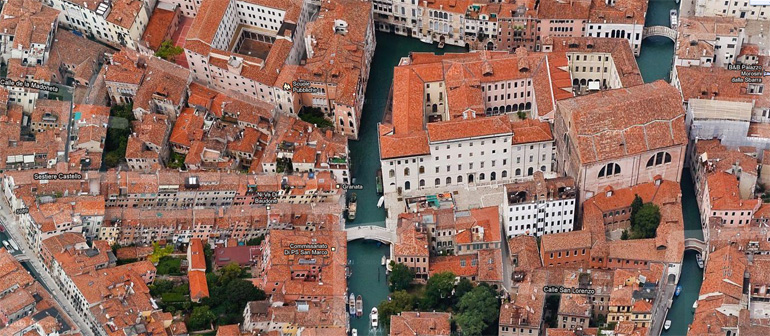Gotham Diary:
Hot Air
Tuesday, 28 June 2011
In her engaging guide to Venice, No Vulgar Hotel, Judith Martin devotes a chapter to visiting the Serenissima with “Your Imaginary Friend.” This would be the poet or artist whose work has kindled your desire to visit Venice in the first place, or kept the flame burning brightly. Dante, Ruskin, Titian, Henry James, Byron — they’re all there and more. So is Donna Leon.
Fans of Donna Leon’s mysteries give themselves away by their abnormal interest in mundane places  — a counterintuitive desire to visit police headquarters or a sudden cry of “Look! That’s where Guido buys flowers for Paola!” For years, we responded to gracious luncheon invitations from friends who cautioned that they lived up ninety-four steps by cajoling them into coming to lunch with us instead. When they let drop that their apartment was used as the home for Miss Leon’s hero, we bounded up those ninety-four steps in a flash, brushed past our hosts and tore through the familiar setting.
Shown above (somewhere) is the Questura, or police headquarters, where Guido Brunetti cajoles Signorina Elettra Zorzi into helping him cope with the zombie careerist, Vice-Questore Patta (a Southerner, wouldn’t you know). I told you about Rome last week; yesterday, I discovered that Google Maps has given Venice the same treatment. Zoom in close, and the satellite pictures give way to breathtaking balloon views. Â
It’s hot and humid today. Not miserably so, but enough to make me feel that summer is no time for working. After lunch with a friend in Turtle Bay, I walked up First Avenue to the storage unit, where I dropped off some winter shirts and picked up some summer shirts, along with a summer bedspread and a summer blanket. As if that weren’t enough to carry around — my next stop was Gracious Home, where I bought a Vornado fan — I tucked in George Sand’s Consuelo. I’d like to tell you something about this novel, but I am trying not to read the jacket descriptions and the introductory material, so all I can say is that Consuelo is very long. Having read the first chapter, I can also tell you that the heroine is a diligent Spanish girl with a beautiful voice who for some reason lives in Venice, possibly in the Eighteenth Century.
My friend at lunch planted the seed, when she asked me what my summer reading project was — would I re-read Proust? She meant that as a jest; it’s the all-purpose, perennial summer project that no one ever gets around to doing (except me; I’ve read In Search of Time Past three times, all during the summer). I thought about taking the Pléiade paperback of the entire cycle out to Fire Island in August, and maybe I’ll do that. I’ve not read Proust in French. But at the storage unit, there was Consuelo, equally fat but written, I expect, with a more circumscribed vocabulary. One is always running to the dictionary with Proust, unless one has the brains to have an English translation open to the same spot. How many times in your life have you looked up acajou, a word that bears absolutely no resemblance to mahogany? It’s all very well for Proust to use lots and lots of different French words, which French people can presumably be expected to know; but it’s awfully hard on the rest of us, and I for one would like to see an edition in which every word that is used fewer than fifty times throughout the novel is translated in the margins. That’s precisely the sort of edition, by the way, that would be a snap to compile for an e-reader, in case anybody ambitious is listening. I have no recollection of a reason for ordering Consuelo from Amazon in Franch, and I really ought to finish François le champi, said to be Proust’s favorite novel as a boy, first. But let’s not get started on the Things That I Ought To Do Instead.
So I’m going to read now — read and tidy up. I made a frightful mess looking for a map of Venice earlier. A map-type map, that is, something that folds up and contains all the traditional information that Google Maps ignores in favor of restaurant locations. (The not-so-little church that I wanted to identify from the aerial image turned out to be Sant’Aponal, which dates from the early Eleventh Century. According to Rizzoli’s The Treasures of Venice, the interior is not open to the public. Imagine that!) The Venice map wasn’t with the other maps, which themselves are secreted in various spots at the moment (a transitional situation); the Venice map was tucked neatly alongside Paris From Above, in a bookshelf by my reading chair. But I didn’t think of that until I’d scattered maps all over the blue room. (The road map for Veneto-Friuli did not serve.) Plus, I’ve got to put the summer bedspread and blanket away for a few days (I’ll change the sheets on Friday), and plug in the new fan somewhere, and run downstairs to collect the mail and pick up something for dinner.  Â
And I’ve got to find where Guido buys flowers for Paola.

